ECU JEEP WRANGLER 2013 JK / 3.G User Guide
[x] Cancel search | Manufacturer: JEEP, Model Year: 2013, Model line: WRANGLER, Model: JEEP WRANGLER 2013 JK / 3.GPages: 132, PDF Size: 3.32 MB
Page 11 of 132
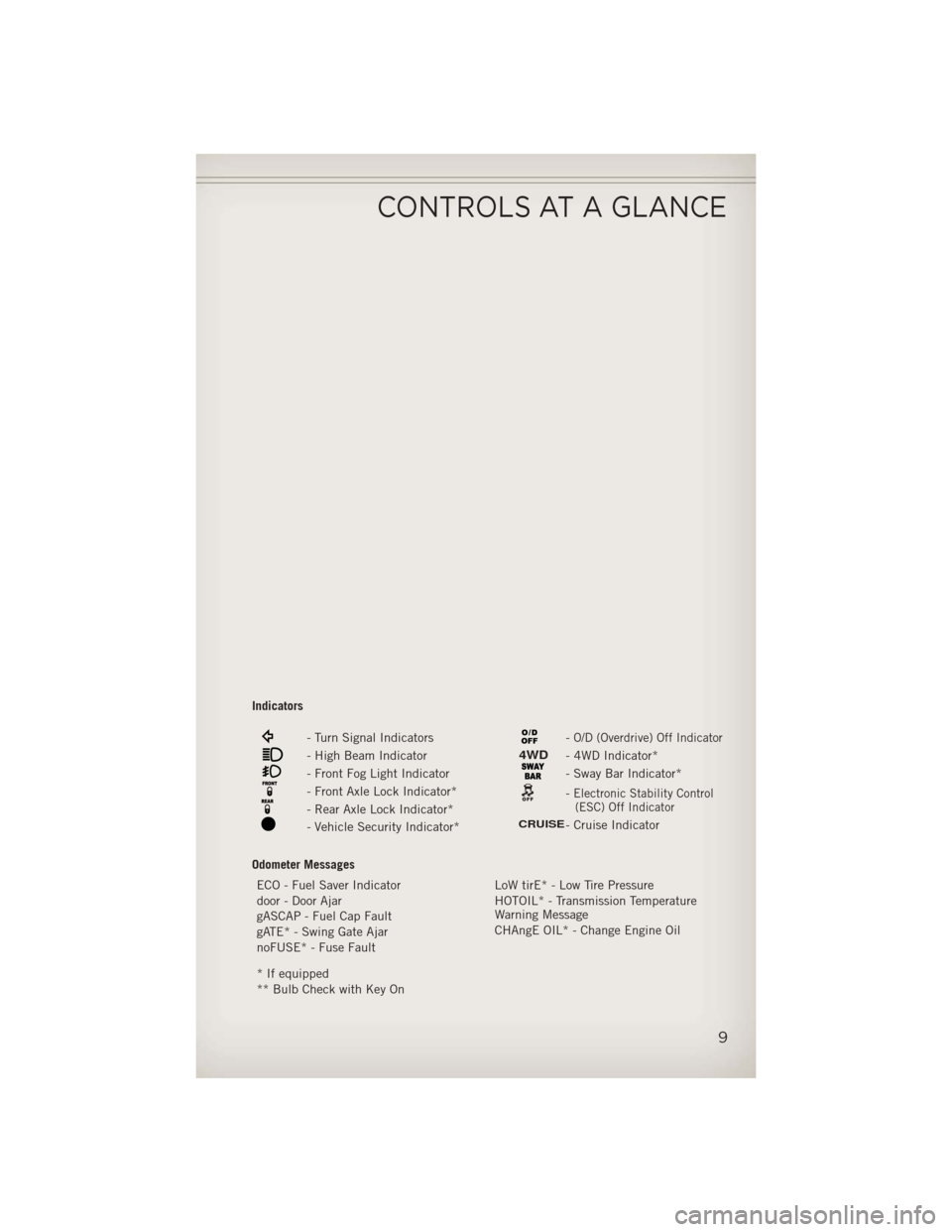
Indicators
- Turn Signal Indicators
- High Beam Indicator
- Front Fog Light Indicator
- Front Axle Lock Indicator*
- Rear Axle Lock Indicator*
- Vehicle Security Indicator*
-O/D (Overdrive) Off Indicator
4WD- 4WD Indicator*
- Sway Bar Indicator*
-Electronic Stability Control(ESC) Off Indicator
CRUISE- Cruise Indicator
Odometer Messages ECO - Fuel Saver Indicator LoW tirE* - Low Tire Pressure
door - Door Ajar HOTOIL* - Transmission Temperature
Warning Message
gASCAP - Fuel Cap Fault
CHAngE OIL* - Change Engine Oil
gATE* - Swing Gate Ajar
noFUSE* - Fuse Fault
* If equipped
** Bulb Check with Key On
CONTROLS AT A GLANCE
9
Page 12 of 132
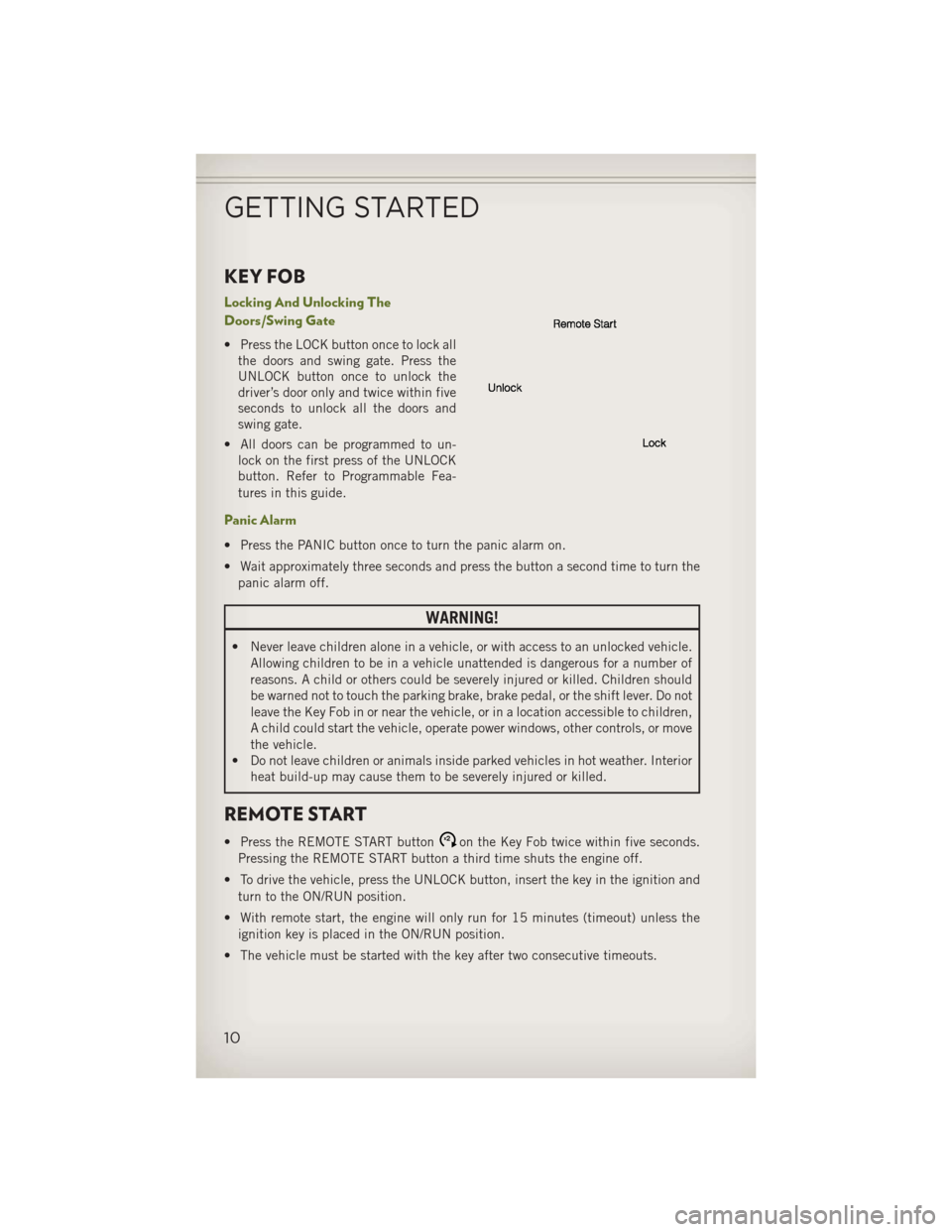
KEY FOB
Locking And Unlocking The
Doors/Swing Gate
• Press the LOCK button once to lock allthe doors and swing gate. Press the
UNLOCK button once to unlock the
driver’s door only and twice within five
seconds to unlock all the doors and
swing gate.
• All doors can be programmed to un- lock on the first press of the UNLOCK
button. Refer to Programmable Fea-
tures in this guide.
Panic Alarm
• Press the PANIC button once to turn the panic alarm on.
• Wait approximately three seconds and press the button a second time to turn the
panic alarm off.
WARNING!
• Never leave children alone in a vehicle, or with access to an unlocked vehicle. Allowing children to be in a vehicle unattended is dangerous for a number of
reasons. A child or others could be severely injured or killed. Children should
be warned not to touch the parking brake, brake pedal, or the shift lever. Do not
leave the Key Fob in or near the vehicle, or in a location accessible to children,
A child could start the vehicle, operate power windows, other controls, or move
the vehicle.
• Do not leave children or animals inside parked vehicles in hot weather. Interior
heat build-up may cause them to be severely injured or killed.
REMOTE START
• Press the REMOTE START buttonx2on the Key Fob twice within five seconds.
Pressing the REMOTE START button a third time shuts the engine off.
• To drive the vehicle, press the UNLOCK button, insert the key in the ignition and turn to the ON/RUN position.
• With remote start, the engine will only run for 15 minutes (timeout) unless the ignition key is placed in the ON/RUN position.
• The vehicle must be started with the key after two consecutive timeouts.
GETTING STARTED
10
Page 15 of 132
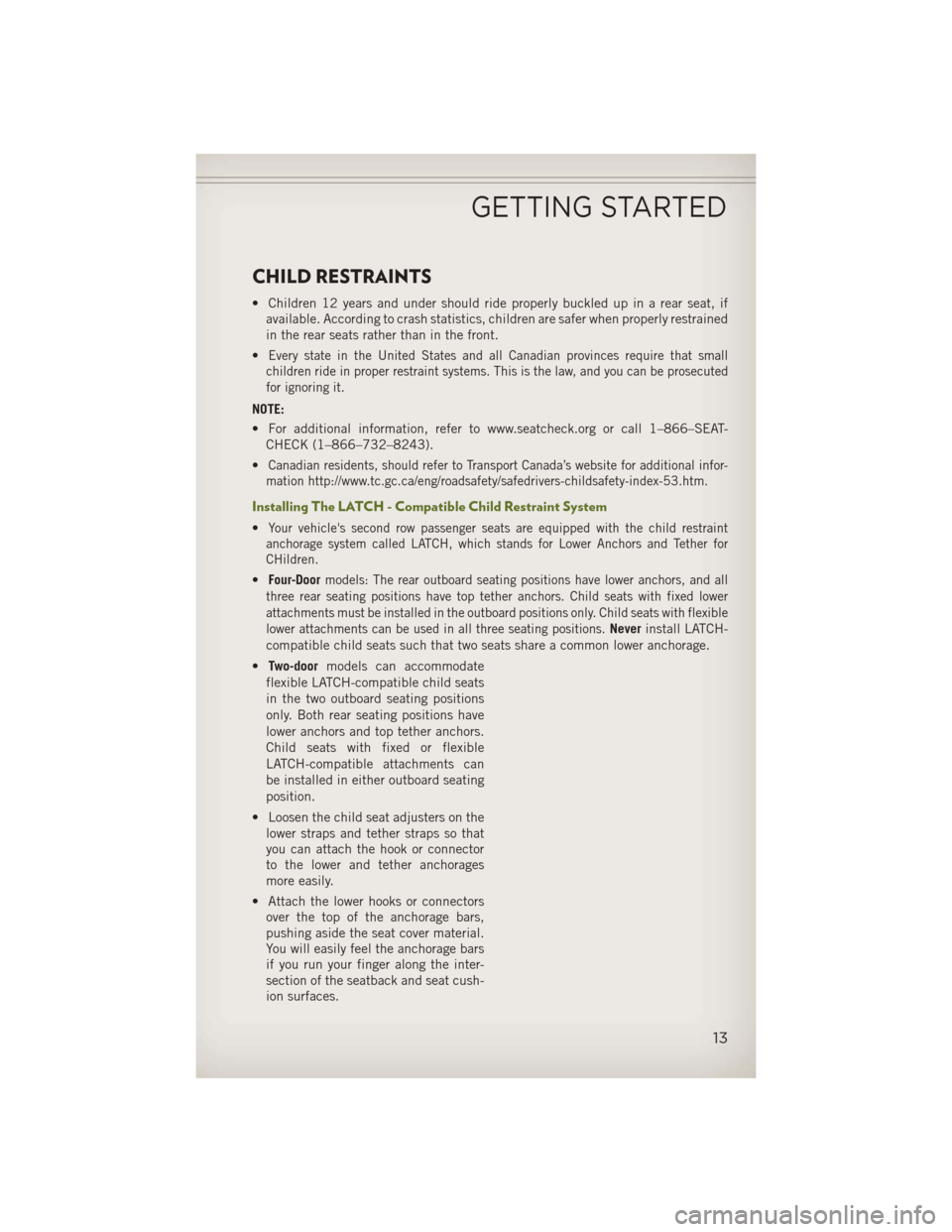
CHILD RESTRAINTS
• Children 12 years and under should ride properly buckled up in a rear seat, ifavailable. According to crash statistics, children are safer when properly restrained
in the rear seats rather than in the front.
•
Every state in the United States and all Canadian provinces require that small
children ride in proper restraint systems. This is the law, and you can be prosecuted
for ignoring it.
NOTE:
• For additional information, refer to www.seatcheck.org or call 1–866–SEAT- CHECK (1–866–732–8243).
•
Canadian residents, should refer to Transport Canada’s website for additional infor-
mation http://www.tc.gc.ca/eng/roadsafety/safedrivers-childsafety-index-53.htm.
Installing The LATCH - Compatible Child Restraint System
•Your vehicle's second row passenger seats are equipped with the child restraint
anchorage system called LATCH, which stands for Lower Anchors and Tether for
CHildren.
• Four-Doormodels: The rear outboard seating positions have lower anchors, and all
three rear seating positions have top tether anchors. Child seats with fixed lower
attachments must be installed in the outboard positions only. Child seats with flexible
lower attachments can be used in all three seating positions.
Never install LATCH-
compatible child seats such that two seats share a common lower anchorage.
• Two-door models can accommodate
flexible LATCH-compatible child seats
in the two outboard seating positions
only. Both rear seating positions have
lower anchors and top tether anchors.
Child seats with fixed or flexible
LATCH-compatible attachments can
be installed in either outboard seating
position.
• Loosen the child seat adjusters on the lower straps and tether straps so that
you can attach the hook or connector
to the lower and tether anchorages
more easily.
• Attach the lower hooks or connectors over the top of the anchorage bars,
pushing aside the seat cover material.
You will easily feel the anchorage bars
if you run your finger along the inter-
section of the seatback and seat cush-
ion surfaces.
GETTING STARTED
13
Page 16 of 132
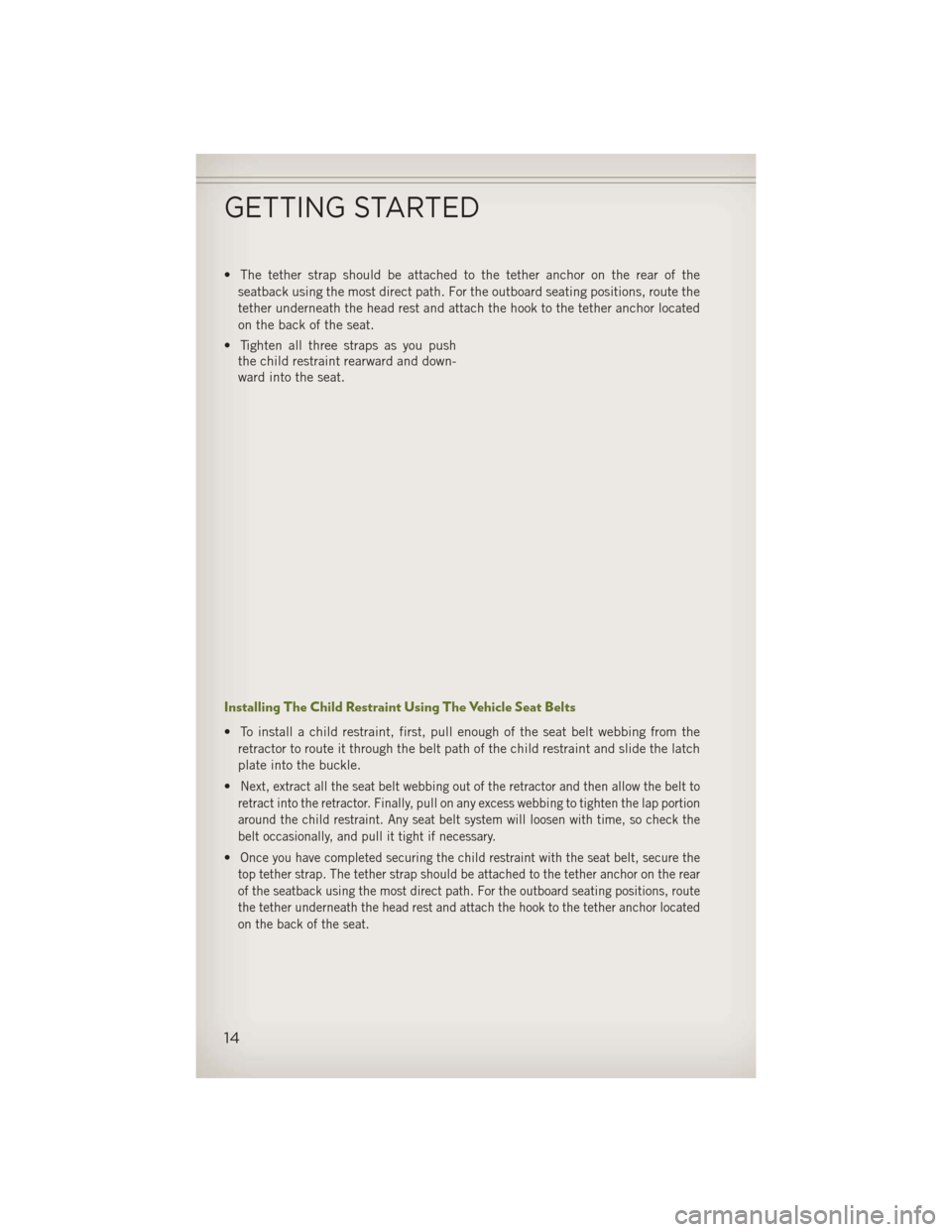
• The tether strap should be attached to the tether anchor on the rear of theseatback using the most direct path. For the outboard seating positions, route the
tether underneath the head rest and attach the hook to the tether anchor located
on the back of the seat.
• Tighten all three straps as you push the child restraint rearward and down-
ward into the seat.
Installing The Child Restraint Using The Vehicle Seat Belts
• To install a child restraint, first, pull enough of the seat belt webbing from the
retractor to route it through the belt path of the child restraint and slide the latch
plate into the buckle.
•
Next, extract all the seat belt webbing out of the retractor and then allow the belt to
retract into the retractor. Finally, pull on any excess webbing to tighten the lap portion
around the child restraint. Any seat belt system will loosen with time, so check the
belt occasionally, and pull it tight if necessary.
•Once you have completed securing the child restraint with the seat belt, secure the
top tether strap. The tether strap should be attached to the tether anchor on the rear
of the seatback using the most direct path. For the outboard seating positions, route
the tether underneath the head rest and attach the hook to the tether anchor located
on the back of the seat.
GETTING STARTED
14
Page 17 of 132
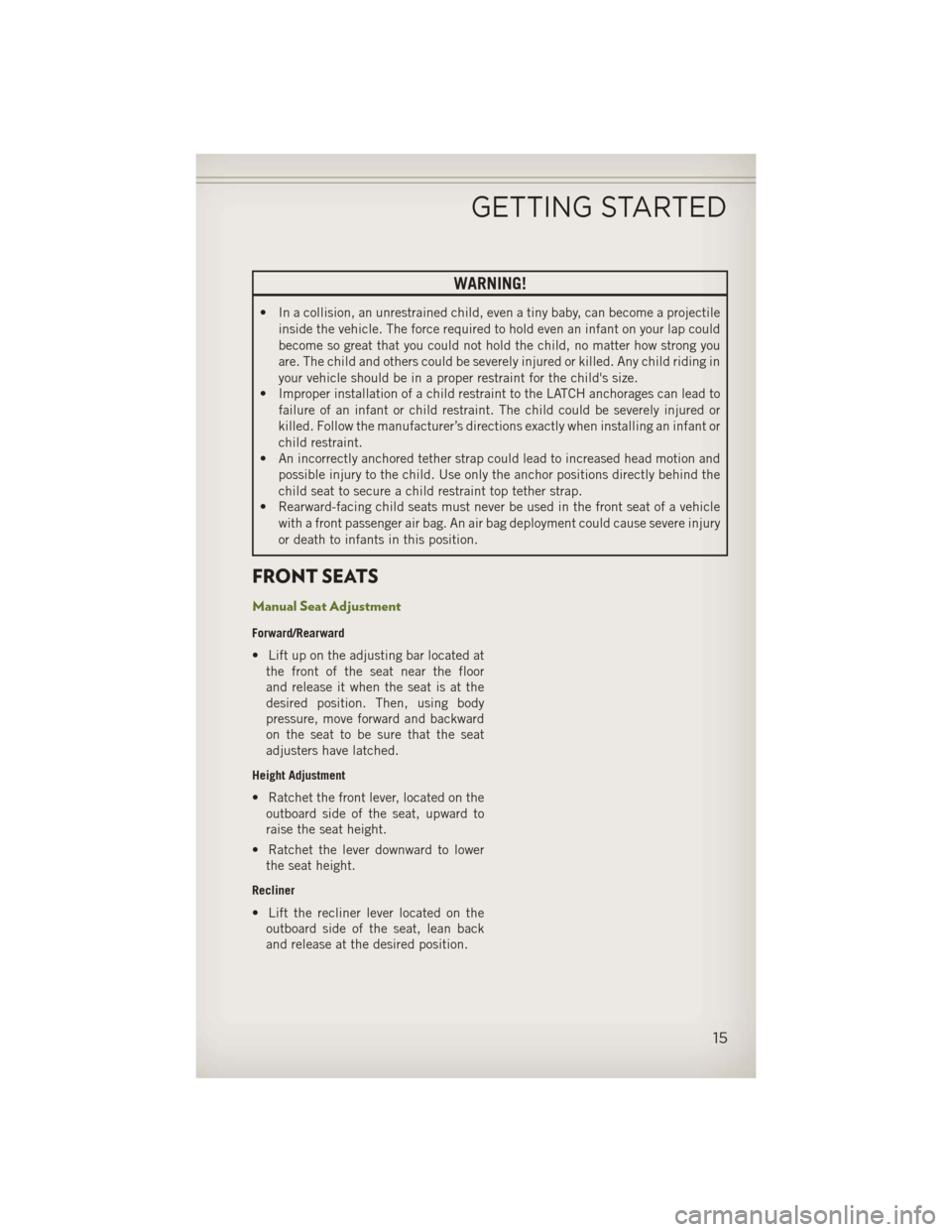
WARNING!
• In a collision, an unrestrained child, even a tiny baby, can become a projectileinside the vehicle. The force required to hold even an infant on your lap could
become so great that you could not hold the child, no matter how strong you
are. The child and others could be severely injured or killed. Any child riding in
your vehicle should be in a proper restraint for the child's size.
• Improper installation of a child restraint to the LATCH anchorages can lead to
failure of an infant or child restraint. The child could be severely injured or
killed. Follow the manufacturer’s directions exactly when installing an infant or
child restraint.
• An incorrectly anchored tether strap could lead to increased head motion and
possible injury to the child. Use only the anchor positions directly behind the
child seat to secure a child restraint top tether strap.
• Rearward-facing child seats must never be used in the front seat of a vehicle
with a front passenger air bag. An air bag deployment could cause severe injury
or death to infants in this position.
FRONT SEATS
Manual Seat Adjustment
Forward/Rearward
• Lift up on the adjusting bar located atthe front of the seat near the floor
and release it when the seat is at the
desired position. Then, using body
pressure, move forward and backward
on the seat to be sure that the seat
adjusters have latched.
Height Adjustment
• Ratchet the front lever, located on theoutboard side of the seat, upward to
raise the seat height.
• Ratchet the lever downward to lower the seat height.
Recliner
• Lift the recliner lever located on theoutboard side of the seat, lean back
and release at the desired position.
GETTING STARTED
15
Page 19 of 132

REAR SEATS
Folding Rear Seat
• Be sure that the front seats are fully upright and positioned forward. This will allowthe rear seat to fold down easily.
To Fold The Rear Seat
• Lift the seatback release lever and fold the seatback forward (two-door models).
• Slowly flip the entire seat (two-doormodels) forward.
• Locate the pull strap, located on the outboard side of the seat, and pull it
toward you until the seatback releases
(four-door models).
To Raise The Rear Seat
• Lift up on the seatback to return it tothe upright position.
WARNING!
• It is extremely dangerous to ride in a cargo area, inside or outside of a vehicle.
In a collision, people riding in these areas are more likely to be severely injured
or killed. Do not allow people to ride in any area of your vehicle that is not
equipped with seats and seat belts. Be sure everyone in your vehicle is in a seat
and using a seat belt properly.
• Be certain that the seatback is securely locked into position. If the seatback is
not securely locked into position, the seat will not provide the proper stability
for child seats and/or passengers. An improperly latched seat could cause you
or others to be severely injured or killed.
GETTING STARTED
17
Page 29 of 132
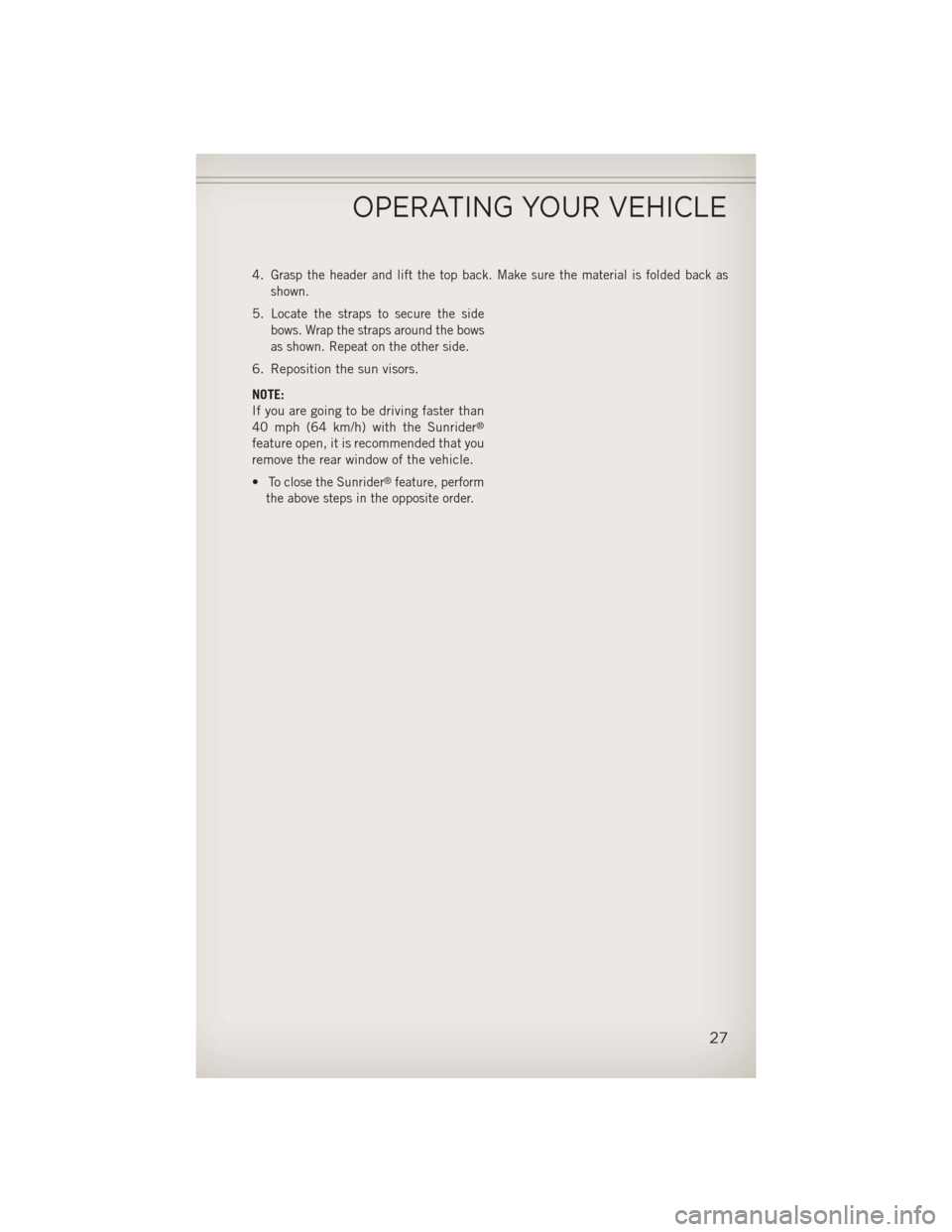
4.Grasp the header and lift the top back. Make sure the material is folded back as
shown.
5.Locate the straps to secure the side
bows. Wrap the straps around the bows
as shown. Repeat on the other side.
6. Reposition the sun visors.
NOTE:
If you are going to be driving faster than
40 mph (64 km/h) with the Sunrider
®
feature open, it is recommended that you
remove the rear window of the vehicle.
•
To close the Sunrider®feature, perform
the above steps in the opposite order.
OPERATING YOUR VEHICLE
27
Page 32 of 132

4. Fold the top so that the material forms a "W" as shown. Enter the vehicle and movethe material into two folds.
5. Fold back the front section of the top and gently rest the header on top of
the rear portion of the deck.
6.
Secure the top by using the two provided
straps. Each strap will wrap around the
side bow and Velcro
®to itself; use one
strap on each side of the vehicle.
NOTE:
•
Failure to fold the fabric rearward will
allow the material to sag and may block
the rearview mirror.
•If you are going to be driving faster than
40 mph (64 km/h) with the Sunrider®
feature open, it is recommended that you
remove the rear window of the vehicle.
•To close the Sunrider®feature, perform
the above steps in the opposite order.
OPERATING YOUR VEHICLE
30
Page 38 of 132
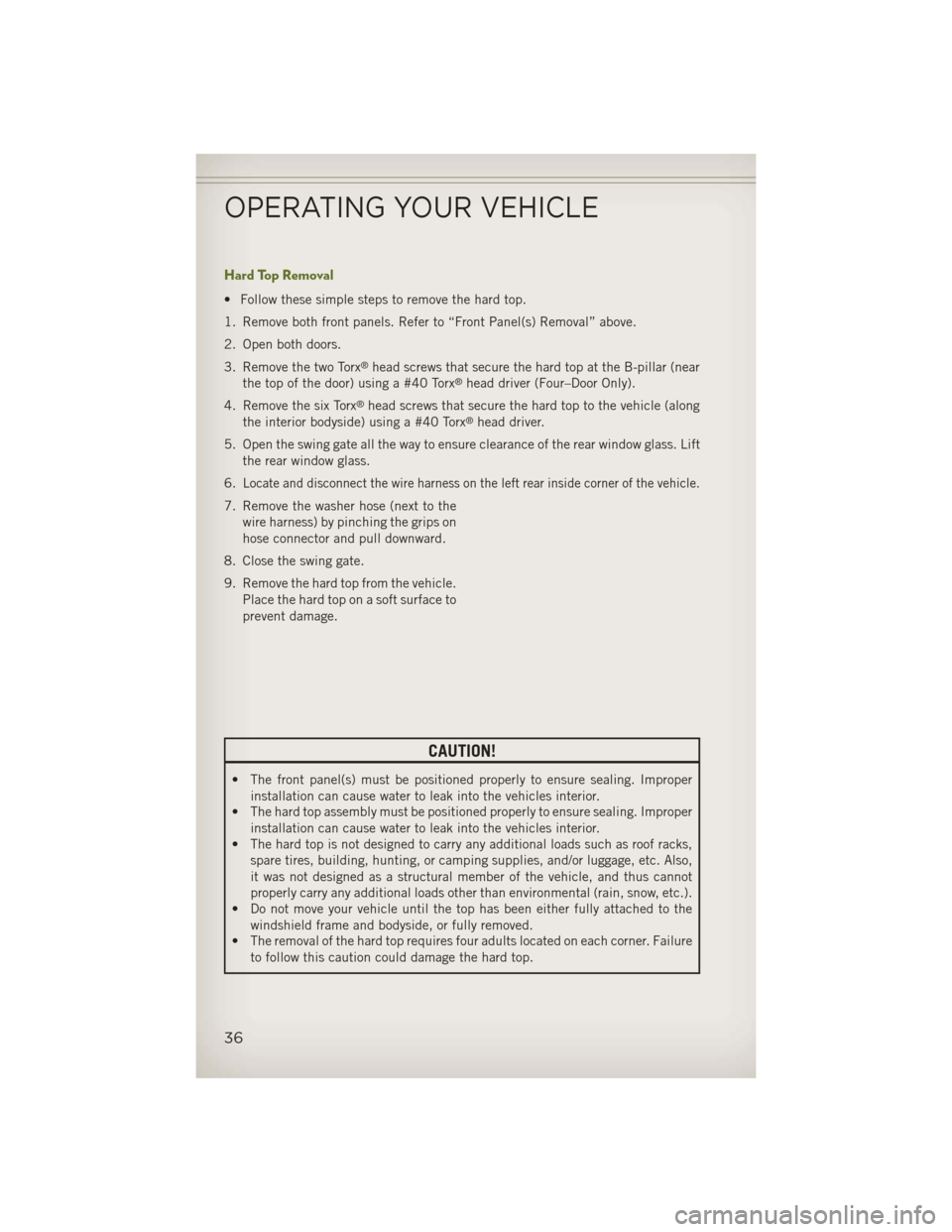
Hard Top Removal
• Follow these simple steps to remove the hard top.
1. Remove both front panels. Refer to “Front Panel(s) Removal” above.
2. Open both doors.
3. Remove the two Torx
®head screws that secure the hard top at the B-pillar (near
the top of the door) using a #40 Torx®head driver (Four–Door Only).
4. Remove the six Torx
®head screws that secure the hard top to the vehicle (along
the interior bodyside) using a #40 Torx®head driver.
5. Open the swing gate all the way to ensure clearance of the rear window glass. Lift the rear window glass.
6.
Locate and disconnect the wire harness on the left rear inside corner of the vehicle.
7. Remove the washer hose (next to the wire harness) by pinching the grips on
hose connector and pull downward.
8. Close the swing gate.
9. Remove the hard top from the vehicle. Place the hard top on a soft surface to
prevent damage.
CAUTION!
• The front panel(s) must be positioned properly to ensure sealing. Improperinstallation can cause water to leak into the vehicles interior.
• The hard top assembly must be positioned properly to ensure sealing. Improper
installation can cause water to leak into the vehicles interior.
• The hard top is not designed to carry any additional loads such as roof racks,
spare tires, building, hunting, or camping supplies, and/or luggage, etc. Also,
it was not designed as a structural member of the vehicle, and thus cannot
properly carry any additional loads other than environmental (rain, snow, etc.).
• Do not move your vehicle until the top has been either fully attached to the
windshield frame and bodyside, or fully removed.
• The removal of the hard top requires four adults located on each corner. Failure
to follow this caution could damage the hard top.
OPERATING YOUR VEHICLE
36
Page 82 of 132
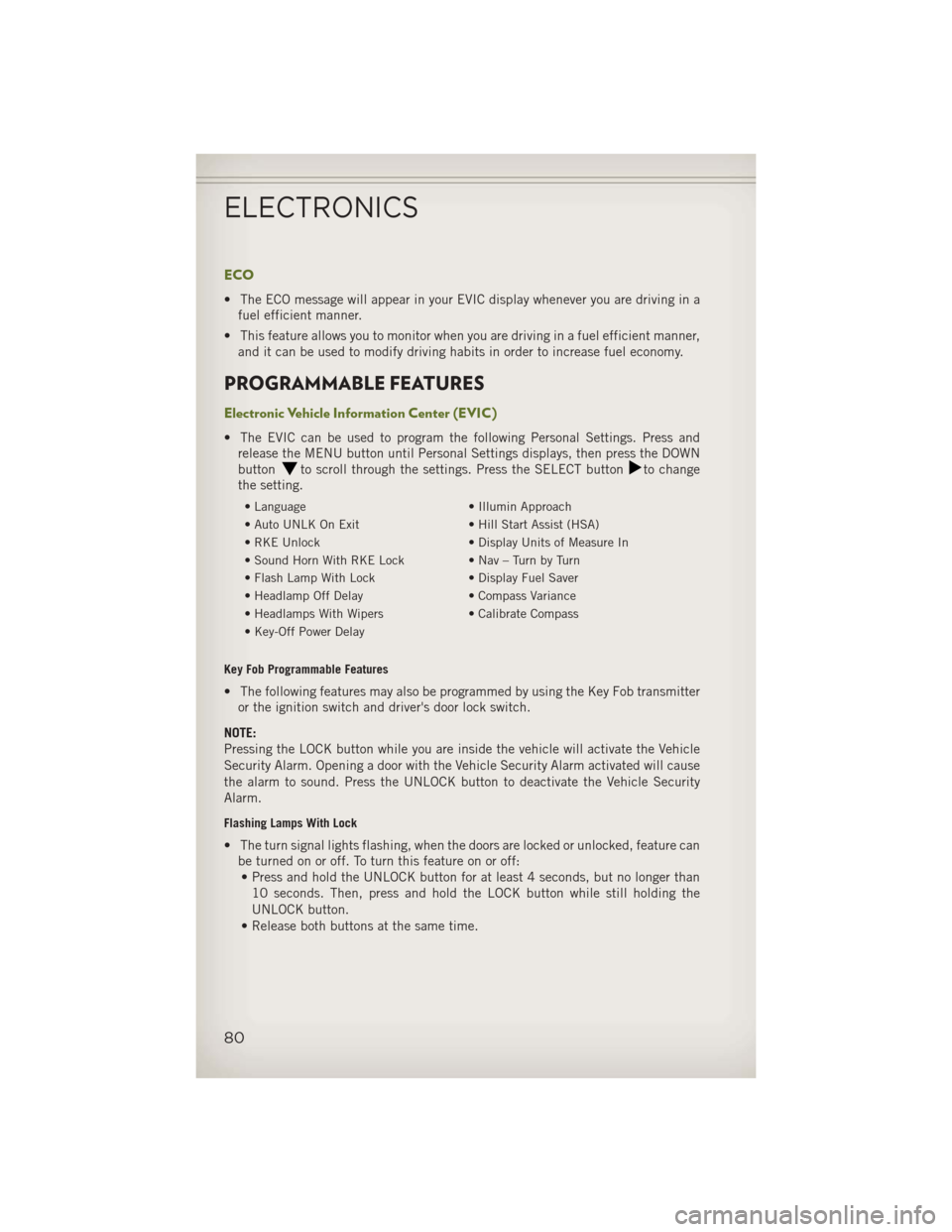
ECO
• The ECO message will appear in your EVIC display whenever you are driving in afuel efficient manner.
• This feature allows you to monitor when you are driving in a fuel efficient manner, and it can be used to modify driving habits in order to increase fuel economy.
PROGRAMMABLE FEATURES
Electronic Vehicle Information Center (EVIC)
• The EVIC can be used to program the following Personal Settings. Press andrelease the MENU button until Personal Settings displays, then press the DOWN
button
to scroll through the settings. Press the SELECT buttonto change
the setting.
• Language • Illumin Approach
• Auto UNLK On Exit • Hill Start Assist (HSA)
• RKE Unlock • Display Units of Measure In
• Sound Horn With RKE Lock • Nav – Turn by Turn
• Flash Lamp With Lock • Display Fuel Saver
• Headlamp Off Delay • Compass Variance
• Headlamps With Wipers • Calibrate Compass
• Key-Off Power Delay
Key Fob Programmable Features
• The following features may also be programmed by using the Key Fob transmitter or the ignition switch and driver's door lock switch.
NOTE:
Pressing the LOCK button while you are inside the vehicle will activate the Vehicle
Security Alarm. Opening a door with the Vehicle Security Alarm activated will cause
the alarm to sound. Press the UNLOCK button to deactivate the Vehicle Security
Alarm.
Flashing Lamps With Lock
• The turn signal lights flashing, when the doors are locked or unlocked, feature can be turned on or off. To turn this feature on or off:• Press and hold the UNLOCK button for at least 4 seconds, but no longer than
10 seconds. Then, press and hold the LOCK button while still holding the
UNLOCK button.
• Release both buttons at the same time.
ELECTRONICS
80